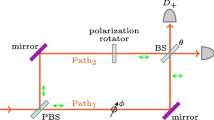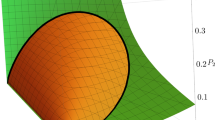Abstract
The logic underlying the coherent nature of quantum information processing often deviates from intuitive reasoning, leading to surprising effects. Counterfactual computation constitutes a striking example: the potential outcome of a quantum computation can be inferred, even if the computer is not run1. Relying on similar arguments to interaction-free measurements2 (or quantum interrogation3), counterfactual computation is accomplished by putting the computer in a superposition of ‘running’ and ‘not running’ states, and then interfering the two histories. Conditional on the as-yet-unknown outcome of the computation, it is sometimes possible to counterfactually infer information about the solution. Here we demonstrate counterfactual computation, implementing Grover's search algorithm with an all-optical approach4. It was believed that the overall probability of such counterfactual inference is intrinsically limited1,5, so that it could not perform better on average than random guesses. However, using a novel ‘chained’ version of the quantum Zeno effect6, we show how to boost the counterfactual inference probability to unity, thereby beating the random guessing limit. Our methods are general and apply to any physical system, as illustrated by a discussion of trapped-ion systems. Finally, we briefly show that, in certain circumstances, counterfactual computation can eliminate errors induced by decoherence.



Similar content being viewed by others
References
Jozsa, R. in Lecture Notes in Computer Science (ed. Williams, C. P.) Vol. 1509, 103–112 (Springer, London, 1998)
Elitzur, A. C. & Vaidman, L. Quantum-mechanical interaction-free measurements. Found. Phys. 23, 987–997 (1993)
Kwiat, P. G. et al. High-efficiency quantum interrogation measurements via the quantum Zeno effect. Phys. Rev. Lett. 83, 4725–4728 (1999)
Grover, L. K. Quantum mechanics helps in searching for a needle in a haystack. Phys. Rev. Lett. 79, 325–328 (1997)
Mitchison, G. & Jozsa, R. Counterfactual computation. Proc. R. Soc. Lond. A 457, 1175–1193 (2001)
Misra, B. & Sudarshan, E. C. G. The Zeno's paradox in quantum theory. J. Math. Phys. 18, 756–763 (1977)
Nielsen, M. A. & Chuang, I. L. Quantum Computation and Quantum Information 248–276 (Cambridge Univ. Press, Cambridge, UK, 2000)
Kwiat, P. G., Mitchell, J. R., Schwindt, P. D. D. & White, A. G. Grover's search algorithm: an optical approach. J. Mod. Opt. 47, 257–266 (2000)
Kwiat, P. G. et al. Interaction-free measurement. Phys. Rev. Lett. 74, 4763–4766 (1995)
Franson, J. D., Jacobs, B. C. & Pittman, T. B. Quantum computing using single photons and the Zeno effect. Phys. Rev. A 70, 062302 (2004)
Rudolph, T. & Grover, L. Quantum searching a classical database (or how we learned to stop worrying and love the bomb). Preprint at http://arxiv.org/quant-ph/0206066 (2002).
Dhar, D., Grover, L. K. & Roy, S. M. Preserving quantum states: A Super-Zeno effect. Preprint at http://arxiv.org/quant-ph/0504070 (2005).
Viola, L. & Lloyd, S. Dynamical suppression of decoherence in two-state quantum systems. Phys. Rev. A 58, 2733–2744 (1998)
Monroe, C., Meekhof, D. M., King, B. E. & Wineland, D. J. A “Schrodinger Cat” superposition state of an atom. Science 272, 1131–1136 (1996)
Brickman, K. A. et al. Implementation of Grover's quantum search algorithm in a scalable system. Phys. Rev. A 72, 050306 (R) (2005).
Rowe, M. A. et al. Experimental violation of a Bell's inequality with efficient detection. Nature 409, 791–794 (2001)
Hong, C. K. & Mandel, L. Experimental realization of a localized one-photon state. Phys. Rev. Lett. 56, 58–60 (1986)
Acknowledgements
We acknowledge discussions with B. DeMarco, and partial support from the National Science Foundation, Disruptive Technologies Office, and the US Army Research Office.
Author information
Authors and Affiliations
Corresponding author
Ethics declarations
Competing interests
Reprints and permissions information is available at npg.nature.com/reprintsandpermissions. The authors declare no competing financial interests.
Supplementary information
Supplementary Methods
This file contains details on the algorithm and the experimental encoding; the experiment; clarifications; and the high-efficiency qubit-by-qubit-interrogation technique. This file also presents a method to interrogate all database elements simultaneously.
Rights and permissions
About this article
Cite this article
Hosten, O., Rakher, M., Barreiro, J. et al. Counterfactual quantum computation through quantum interrogation. Nature 439, 949–952 (2006). https://doi.org/10.1038/nature04523
Received:
Accepted:
Issue Date:
DOI: https://doi.org/10.1038/nature04523
- Springer Nature Limited
This article is cited by
-
Counterfactual communication without a trace in the transmission channel
npj Quantum Information (2023)
-
Multiple quantum interrogation to determine the position of an object in a serial array of ring resonators
Scientific Reports (2023)
-
Optimal Convergence Rate in the Quantum Zeno Effect for Open Quantum Systems in Infinite Dimensions
Annales Henri Poincaré (2023)
-
“Interaction-Free” Channel Discrimination
Annales Henri Poincaré (2022)
-
A dynamical quantum Cheshire Cat effect and implications for counterfactual communication
Nature Communications (2021)





